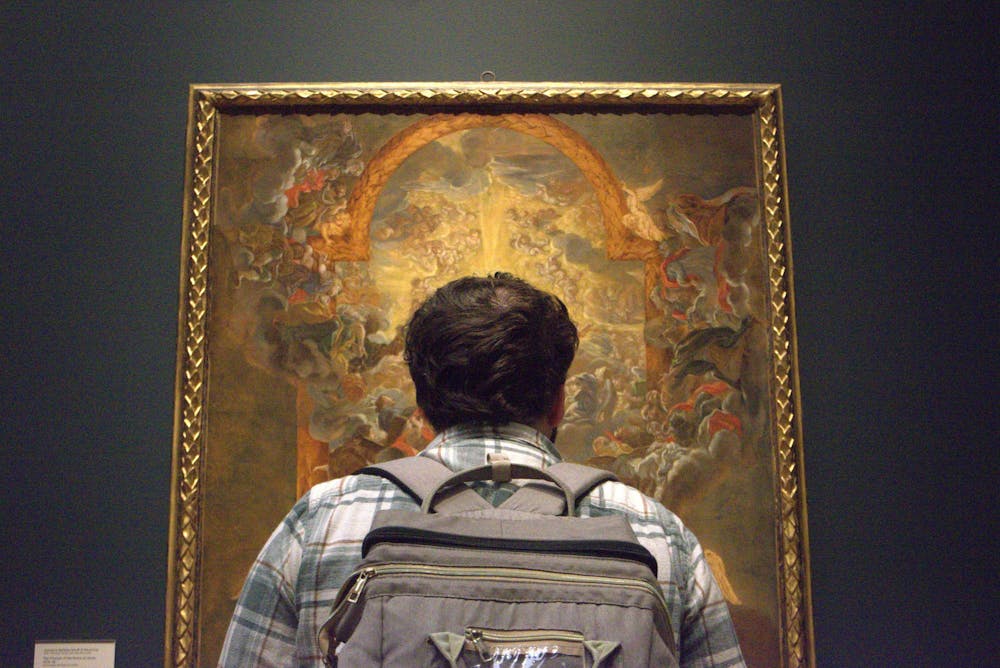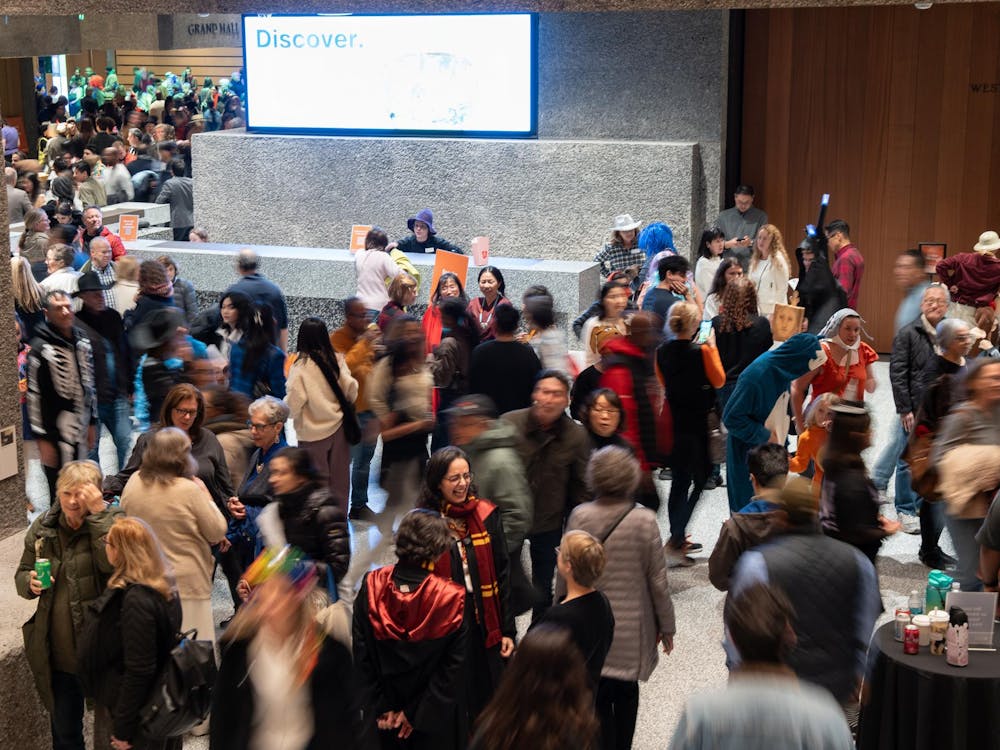As I first stepped into the European Art pavilion, I found myself surrounded by color: maroon, gold, and blue hues covered the walls as ceramics, paintings, and prints from diverse eras, artists, and regions converged. Yet the pavilion goes beyond unifying an eclectic color palette — it also offers a powerful message on cultural intersection.
One of the works I was most moved by was the renowned Alfred Stevens painting, “The Psyché (My Studio).” Its intricately painted refined art studio space, with the delicate woman peeking from behind the mirror to meet my eye in the reflection drawing me over for a closer look, strikingly contrasts a painting by the lesser known Berta Wetman’s “Interior.” Wetman’s painting mirrors the subject matter and perspective of Stevens’ work, but with a grittier, simpler beauty absent of a female muse.
The curatorial choice of creating conversations between known and less-known artists complemented one another, encouraging me to learn more about every piece. The pairings brought pieces unfamiliar to me to the forefront, expanding the context and meaning of the piece alone into one that encompasses the works on the walls surrounding it and the pavilion itself.
Even the corridor that flanks the pavilion’s entrance highlights pieces of seemingly non-European origin. Three central objects dominate the corridor: the Incan Cup of Montezuma brought to Spain in the 17th century, an Indian ewer made for the British Empire, and a West African ivory spoon brought to Portugal. According to Associate Curator Alexandra Letvin, the pieces are “not European, but that circulated in Europe.”
While this may appear strange, Letvin says this choice was intentional: “objects that circulated in Europe had a European provenance unintentionally, or were intentionally made for European audiences.” Letvin added that she aimed to “show Europe looking outwards, not just looking inwards.”
“Europe is and has long been a crossroads — a diverse continent with many cultural traditions,” said Annemarie Ike GS ’23, Lecturer in the Princeton Writing Program and Art History Ph.D.. Display of European art has often centered on white, traditional voices while obscuring the diverse and complex nature of populations colonized and integrated. Yet the new openness and interdisciplinary nature of the museum help convey this reality, as a metaphor for the continent itself: porous, dynamic, and in constant exchange.
In the University’s old art museum, European art dominated the main level, leaving little room for art of other cultures. The new museum equalizes this space, with each pavilion sharing roughly the same footprint, and an open floorplan that allows each room to flow into the other. As I walked through and inevitably got lost, this openness and exchange between cultures and histories certainly came through in proximity between diverse pieces alone.
“The collection is laid out more or less chronologically and geographically,” Letvin explains. The Art Museum has long been a teaching center for professors and students in the Art History department, and Letvin has intentionally maintained this teachability by keeping content in thematic groupings in addition to chronological organization.
To achieve this fluidity, Letvin outlined three driving points, beginning with, “Europe's place within a global world,” she explained. Works from India, Africa, and more find a home directly in the pavilion, creating a new and complex vision of Europe and its relationship with other countries.
“I like to push back on the term masterpiece. And so one thing that we started using when we were thinking about these galleries, but really the whole museum was the idea of anchor objects,” Letvin said. Anchor objects are used to engage other works to generate new interpretations of the work. Examples range from Gérôme’s “Napoleon in Egypt” and Monet’s “Water Lilies” to works by unknown artists.
The well-known works are recognizable but don’t dominate — they contextualize and inform the works that may be more obscure. This representation of lesser-known works and works across cultures even lends itself to the more famous pieces like Manet’s Woman with a Cigarette, which, as Iker noted, “because of the uncertainties about the identity of its subject, seems to be at home in a new way in the new [pavilion].”
Exploring the pavilion’s four galleries, the works seemed to flow into one another, a woven tapestry of intersecting media, cultures, and time periods. The contrast between these artistic factors and origins kept me curious about every piece and its place in the world, and that curiosity could have kept me walking around for hours.

This ambitious philosophy of centering non-European art is realized through Letvin’s choice to host a case of works in the central corridor of the pavilion as opposed to a single “important painting.” The case of works highlights the “circulation of commodities throughout Europe and so, in a sense, becomes a more personal reflection of the stories that these three objects are telling.” This recenters high art on a personal level, a theme that aids the sense of an interconnected global community on an intimate scale while simultaneously rewriting what defines ‘European art.’
Many visitors come to museums seeking the most famous pieces, but in doing so, they miss the chance to truly learn from what they are experiencing. In choosing pieces that are less well known or unconventionally European, visitors can expand their idea of what art is worthy of witnessing.
Through this focus on exchange in geography, layout, and media, Letvin leaves visitors with a clear message: “I hope that they leave the pavilion thinking that Europe is more connected to the world around it, and I also hope that they will see that Europe’s boundaries shift over time ... I hope that people understand [the Art Museum] as a place within a connected world.”
Devon Williams is a contributing writer for The Prospect and a member of the Class of 2028. She can be reached at dw9268@princeton.edu.
Please send any corrections to corrections[at]dailyprincetonian.com.








